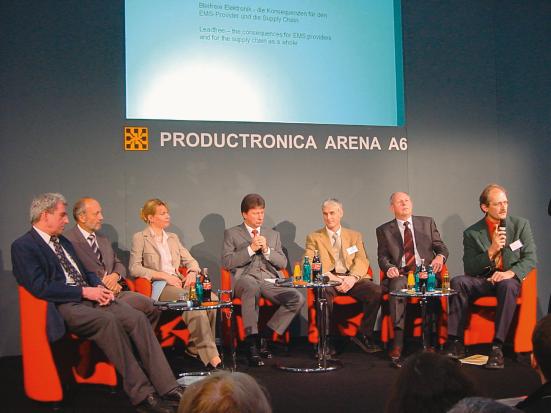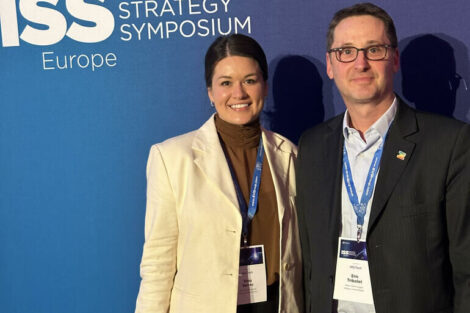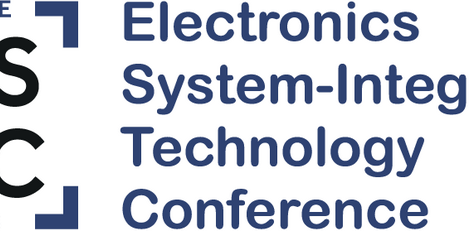“Lead-free electronics – consequences for EMS and the supply chain” was the subject of a well-attended panel discussion during Productronica in Munich, Germany, bringing together seven experts on the difficult transition to EU-mandated, lead-free consumer electronics. “The time remaining until July 1, 2006, is real short,” lead-free pundit Gundolf Reichelt exhorted the forum audience. “Especially if you have to perform the qualifications, train your employees and adjust the equipment.”
The WEEE and ROHS directives of the EU Commission were implemented in February of 2003. “I urge everybody who hasn’t begun yet to do it right away,” Gundolf Reichelt of a Berlin-based iniative of 55 companies tackling with lead-free introduction (Fachkreis Bleifreie Elektronik) underlined. Lead-free is a highly competitive issue as the forum made clear time and again. In other words, the logistics of getting there in time is taking center stage. The theoretical debates of the last several years have abated. Solutions or, at least, options for materials and processes are available or in place.
The first cut is the deepest
According to the initiative’s experience, the first and foremost step is the selection of the lead-free solder. “We have made thorough research on plenty of alloys, about a dozen, in our circle,” Reichelt remembered. They didn’t favorize the tin-silver-cooper formula, but realized that all key alloys such as tin-silver-cooper, tin-cooper and tin-cooper-nickel have widely comparable spectra of characteristics in their process behavior and the reliability issues. “Reflow soldering itself isn’t critical, but the reliability problem is crucial, especially as we didn’t have the needed data for all the key alloys, even though we are working hard on resolving this demanding question.”
As Reichelt further pointed out, the other realm of headaches is the availability of lead-free components and their strength against raised temperatures. Those who started early in their group of companies using the tin-silver-cooper solder with its liquidus of 217 °C, would scarcely switch over to tin-cooper with its 227 °C. “This is 10 K higher and cannot be accepted because of the sensitivity of the current components to higher temperature”. But during the last months he got the impression that the component industry is moving forward to tin-cooper technology, and will provide in future parts which are themselves processed with 250/260 °C. They would of course withstand board-soldering temperatures of 227 °C, provided their other materials would comply.
Motorola’s foray into lead-free territory is guided by a specific roadmap for their products, step by step. “We will offer lead-free finishes first”, packaging program manager Mervi Paulasto stated, “then will go on to mould materials to secure halogen-free solutions.”
Tyco Electronics AMP takes a more advanced position – in part due to the automotive end-of-life regulation (ELV). “Already in the run-up (to RoHS),” says Jochen Horn, manager engineering support at Tyco. “Our automotive program was turned lead-free, at least as far as connectors were concerned”. At this point, according to him, there is no product of the company with a lead finish left on the European market.
More complex is the situation at distributor Spoerle Electronics, who carries an inventory valued at €250m. This is causing logistics problems, VP Gunther Schneider declared. “There will be customers that want to transition earlier – meaning we will have double, triple, quadruple inventory costs just to ensure that lead-free product categories are on hand – and do not accidentally get mixed in with the older leaded parts”. Specific part numbers, Schneider said, would greatly help.
With Kaizen strategy to fresh insights
Similar but more optimistic is the outlook at EMS provider BuS Elektronik, which manufactures 2,000 products for 150 customers, maintaining an inventory of some 40,000 parts. “A multitude of parameters would have to be switched around on day X,” assumed CEO Werner Maiwald. “That I can’t do, it won’t work”. Consequently, there will be a drawn-out transition from old to new. As a smaller manufacturer, BuS doesn’t do extended research on new materials and processes. Instead, Maiwald trusts his experience as a practitioner, as he did back in the 1980s when the Japanese switched from through-hole assembly to SMT. “The theories were adjusted then and things worked out”. This aspect of the Kaizen strategy can help. EMS providers will have to adopt various lead-free materials and processes – according to their customers‘ demands. This, Maiwald maintains, opens new chances as well. They can gain market share by differentiating their competences and leveraging their experience from contracting with diverse customers.
Can you continue producing with existing equipment? Hans Bell of Rehm Anlagenbau, vendor of reflow-solder systems, was asked. “Yes, you can, very well,” was his insight. At least on equipment delivered after 2000 in general. According to Bell, this applies to reflow as well as wave and selective soldering. Convection systems, says Bell, will work in the lead-free era, at least with smaller boards (up to 1.5 kg of weight). Beyond that, he supposes, condensation (vapor-phase) could do the trick. At a 217 °C liquidus for tin-silver-copper, problems could arise with package materials sensitive to humidity due to high thermal-energy absorption. As a possible solution, he sees “backside reflow” instead of wave soldering. Another problem with older machines, says Bell, will be corrosion caused by tin. Wetability, on the other hand, when using pure tin, doesn’t seem to be a serious stopper.
There are two basic and overlapping issues to track in the run-up to mid-2006, as Gundolf Reichelt understands it: first, components have to match the EU mandate by being lead-free; second, they should endure the higher temperature stress of Pb-free soldering. Only this way, they would be “fully compatible”. That’s no problem with newer components, Tyco’s Horn and Motorola’s Paulasto replied. In components, solder is mainly used for plating, tinning and/or internal soldering of the terminations.
That leads to the question of how to mix old and new components in a lead-free process – as will be the custom until 2006. Again: “not a problem” according to Thomas Ahrens of Fraunhofer. “Lead-free surfaces can be wetted with lead as well as no-lead solder.” Possible exceptions are BGAs. “We recommend a minimum solder temperature of 235 °C,” stated Paulasto. “With this, we see compatibility with tin-plated legacy products”.
Several other issues were brought up and touched upon – whether new design rules would be needed for lead-free processing. Generally not, says Gundolf Reichelt: “As a first approximation, you can work within the old design rules for SMD”. Werner Schulz/gbw
EPP EUROPE 403
The lead-free forum participants
- Dr. Thomas Ahrens, specialist for processing and analytics of electronics assembly, Fraunhofer Institut Silicon Technology, Itzehoe
- Dr. Hans Bell, head of F&E and technology, Rehm Anlagenbau, Blaubeuren-Seissen
- Dr. Jochen Horn, manager engineering support, Tyco Electronics AMP, Bensheim
- Dr. Werner J. Maiwald, founder and CEO BuS Elektronik, Riesa
- Mervi Paulasto, packaging program manager, Motorola Semiconductor, Munich
- Dr. Gundolf Reichelt, head of the lead-free working group, Berlin
- Gunther Schneider, VP marketing and sales, Spoerle Electronic, Dreieich
A collection of helpful links on Pb-free
Share:










